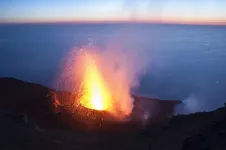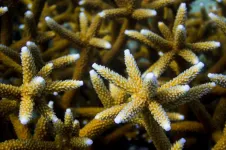(Press-News.org) What causes an eruption? Why do some volcanoes erupt regularly, while others remain dormant for thousands of years? A team of geologists and geophysicists, led by the University of Geneva (UNIGE), Switzerland, has reviewed the literature on the internal and external mechanisms that lead to a volcanic eruption. Analyzing the thermo-mechanics of deep volcanic processes and magma propagation to the surface, together with magma chemistry, the geologists determined that most of the magma rising from depth actually does not cause a volcanic eruption. They also show that older volcanoes tend to produce less frequent, but larger and more dangerous eruptions. Their findings, published in Nature Reviews Earth and Environment, will help refine models of volcanic processes to reduce the impact of volcanic eruptions on the more than 800 million people living near active volcanoes.
Volcanic activity remains difficult to predict even when it is closely monitored. Why didn't Mount Fuji erupt after the strong earthquake in Tohoku, Japan? Why did the eruption of Eyjafjallajökul generate such a large amount of volcanic ash? In order to determine the causes of volcanic eruptions, geologists and geophysicists led by Luca Caricchi, professor at the Department of Earth Sciences of the Faculty of Science of the UNIGE, have taken up the existing literature and analysed all the stages that precede an eruption.
The path of magma from the depths of the Earth
Magma is molten rock that comes from tens of kilometres depth and rises to the Earth's surface. "During its journey, magma can get trapped in reservoirs within the Earth's crust, where it may stagnate for thousands of years and potentially never erupt", explains Meredith Townsend, a researcher at the Department of Earth Sciences of the University of Oregon (USA). Specialising in thermomechanical modelling, the American researcher focused on calculating the pressure required for the magma to break up the rocks surrounding the reservoir and rise to the surface. Eleonora Rivalta, a researcher at the Potsdam Research Centre for Geosciences (Germany) and the University of Bologna (Italy), studied the propagation of magma as it rises to the surface: "If it is runny enough, that is if it does not contain too many crystals, magma can rise very quickly by a sort of self-propelled fracking", she continues. If magma crystallises more than 50%, it becomes too viscous and its march towards the surface stops. Magma can also take different paths, vertical, horizontal or inclined. Luca Caricchi specialises in magma chemistry, which provides vital information about the state of the magma before a volcanic eruption occurs. "The chemistry of magma and the crystals it contains provide vital information on the sequence of events leading to a volcanic eruption, which is valuable to better interpret the monitoring signals of active volcanoes and anticipate- whether an eruption might occur", explains the Geneva-based researcher. Finally, Atsuko Namiki, a researcher at the Graduate School of Environmental Studies at Nagoya University (Japan), has analysed the external triggers of an eruption, such as earthquakes, tides or rain: "These alone cannot cause an eruption, the magma has to be ready and awaiting a trigger."
"For an eruption to take place, several conditions must be met simultaneously. Magma with less than 50% crystals must be stored in a reservoir", begins Luca Caricchi. Then this reservoir must be overpressurised. The overpressure can be the result of internal phenomena such as a renewed injection of magma or the exsolution of magmatic gases or it can rise to critical values because of external events such as earthquakes. Finally, once the pressure is sufficient for the magma to start rising, there are still many obstacles that can prevent the magma from erupting.
The age of the volcano as a primary criterion
This comprehensive analysis sheds a light on the behaviour of volcanoes that can change over their lifetime. "When a volcano is just starting to be active, its reservoir is rather small (a few km3) and the surrounding crust is relatively cold, which leads to many frequent, but small and rather predictable eruptions", explains Luca Caricchi. It's a different story with old volcanoes. "Their reservoir is bigger and the rocks around them are hotter. When new magma is injected, it does not generate much overpressure because the rocks around the reservoir deform and the growth continues", says the geologist. As an example Mt St Helens (USA) started erupting 40'000 years ago (a time lapse by geological standards) and its last eruption in 2008 was small and not dangerous. On the contrary, Toba (Indonesia) started erupting explosively about 1.2 million years ago and its last eruption 74000 years ago was cataclysmic. It totally destroyed the surroundings and had an impact on global climate.
Eventually, the accumulation of large amounts of magma will lead to large eruptions. "Moreover, the warning signs are very difficult to detect because the high temperatures decrease seismic activity and the interaction between gases and magma modifies their composition, making it harder to understand what is going on underneath", he says. The higher the rate of magma input, the faster the volcano 'ages'.
Knowing the age of the volcano, which can be dated by analysing the zircon in the rocks, allows geologists to understand the stage of life of the volcanoes. "There are currently 1,500 active volcanoes, and about 50 of them erupt each year. Knowing whether or not to evacuate the population is crucial and we hope that our study will contribute to decrease the impact of volcanic activity on our society", continues Luca Caricchi. "Hopefully our findings will be tested on volcanoes that have been studied extensively, such as those in Italy, USA and Japan, and transferred to other volcanoes for which there are less data, such as in Indonesia or South America."
INFORMATION:
A new study published in Nature Communications demonstrates the important role that planting new commercial forests could play in the fight against climate change by including new accounting of greenhouse gas (GHG) mitigation achieved from future use of harvested wood.
The study applied a novel, time-dependent assessment to capture the complex dynamics of carbon uptake, storage and partial eventual release back to the atmosphere, alongside product and energy substitution by wood products, over a 100-year timeframe.
Uniquely, the study considered multiple wood uses along multi-decadal cascading value chains (e.g. construction timber to paper to bioenergy), and future projections on wider decarbonisation of substituted ...
Although the emissions targets for aviation are in line with the overall goals of the Paris Agreement, there is a high likelihood that the climate impact of aviation will not meet these goals, according to a new study.
Aviation is an important contributor to the global economy, but contributes to climate change by creating carbon dioxide (CO2) as well as non-CO2 effects such as forming nitrogen oxides, ozone and contrailcirrus clouds, which all contribute to global warming.
Researchers believe that, as long as the industry stages a recovery, the restrictions placed on global air travel in response to COVID-19 lockdown will only have ...
Warming seas are driving many species of marine life to shift their geographic ranges out of the tropics to higher latitudes where the water is cooler. Florida's reefs will not be able to make that northward move, however, as they will be caught between intolerably hot tropical waters and increasingly frequent water-cooling cold snaps, according to new findings from Florida Institute of Technology, the U.S. Geological Survey, and several other institutions to be published June 22 in Nature's Scientific Reports.
Populations of the main species of reef-building corals are ...
Published in The Lancet Regional Health - Europe and part-funded by National Institute for Health Research (NIHR) Maudsley Biomedical Research Centre, the study identified that people with multiple respiratory conditions were most likely to develop depression and anxiety later on. This has possible implications for future healthcare services if the Covid-19 pandemic brings about increases in long-term respiratory issues. The study confirms the importance of integrating mental health support early into care plans for those with multiple physical health conditions.
This is the first study of ...
6.4% of the European population suffers from depression, according to a study published in The Lancet Public Health. The work was led by researchers from King's College London, the Hospital del Mar Medical Research Institute (IMIM), the Parc de Recerca Sant Joan de Déu-Institut de Recerca Sant Joan de Déu, the Institute of Biomedicine at the University of León (IBIOMED), and the CIBER on Epidemiology and Public Health (CIBERESP). This figure is higher than that estimated by the World Health Organisation (WHO), which calculated the prevalence of this pathology ...
BEER-SHEVA, ISRAEL, June 22, 2021 -- Researchers at Ben-Gurion University of the Negev (BGU) have developed the first methodology to assess symptoms associated with continuous exposure to traumatic stress from rocket attacks and other security threats, which are not currently measured by diagnostic criteria.
Published in the journal END ...
Researchers have shown why people with mental health disorders, including anorexia and panic disorders, experience physical signals differently.
The researchers, from the University of Cambridge, found that the part of the brain which interprets physical signals from the body behaves differently in people with a range of mental health disorders, suggesting that it could be a target for future treatments.
The researchers studied 'interoception' - the ability to sense internal conditions in the body - and whether there were any common brain ...
Post-traumatic stress disorder (PTSD) and migraine often co-occur, but researchers knew relatively little about how or why this happens. A new study in Frontiers in Neuroscience is the first to investigate if the conditions have a common genetic basis. By studying identical twins, where one twin in each pair lives with PTSD or migraines and the other twin does not, the researchers found common genes that may play a role in both conditions. These genes may help to explain why the conditions co-occur, and could reveal new treatment targets for both.
PTSD is a psychiatric disorder that typically occurs after a traumatic experience, such as a life-threatening event. Most people will experience a traumatic event ...
Plastic is practical, cheap and incredibly popular. Every year, more than 350 million tonnes are produced worldwide. These plastics contain a huge variety of chemicals that may be released during their lifecycles - including substances that pose a significant risk to people and the environment. However, only a small proportion of the chemicals contained in plastic are publicly known or have been extensively studied.
A team of researchers led by Stefanie Hellweg, ETH Professor of Ecological Systems Design, has for a first time compiled a comprehensive database ...
BINGHAMTON, N.Y. -- Mental distress tends to be lower in the summer when compared to the fall, according to new research from Binghamton University, State University of New York.
"Our results suggest that summertime is associated with better diet quality, higher exercise frequency and improved mood. This is important for the post-COVID era as we are getting into the summer season," said Lina Begdache, assistant professor of health and wellness studies at Binghamton University.
Begdache had previously published research suggesting that mental ...

